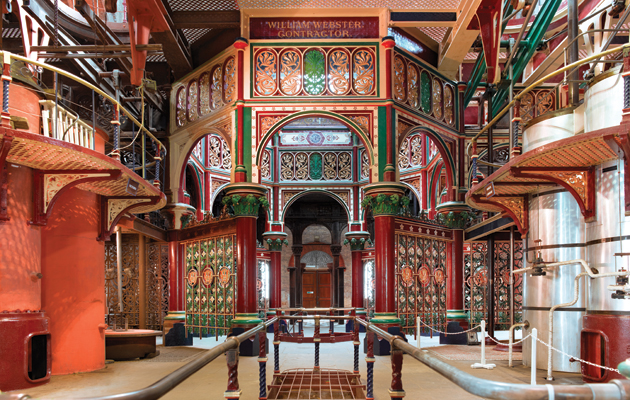|
|
||
|
Bazalgette’s pumping station, now re-opened, is functional design at its most glorious, writes John Jervis It is invigorating when you encounter design. Not some temporary pavilion grasping at a purpose beyond burnishing its designer or sponsor’s reputation. Nor a hip retail cluster in a warehouse conversion, pedalling the same moustache-waxing creams and leather satchels as all such districts. The Crossness Pumping Station, a Victorian sewage plant in east London, is design. Its re-opening has been made possible by ordinary people, working hard, for free, for almost 30 years. And it is magnificent. Crossness was built by Joseph Bazalgette for the Metropolitan Board of Works in 1865 to receive effluent from south London, courtesy of his famed sewerage system, and pump it into the Thames. Externally, it resembles a Victorian town hall, library or museum – a proud municipal statement in the middle of nowhere, proclaiming its vital role in the elimination of filth and disease from the capital. Sympathetic additions followed, but its mansard roof and clocktower were removed in the 1930s and its extravagant campanile-cum-chimney was razed in 1958. Yet its Romanesque grandeur remains intact, as do the varied corbels on its heavy doorways and serried windows, including one that depicts Bazalgette himself. Inside is the original engine hall: four huge beam engines rising 23m over multiple storeys, each named after a member of the royal family. Following decades of neglect – the entire complex was scheduled for demolition in the 1950s – one of these, Prince Consort, has been restored to working condition, and is now steamed up once a month, setting 160 tonnes of metal in extraordinary motion. Around the engines is a network of walkways, spiral staircases and a spectacular central rotunda of cast iron, ornamented with flowers and figs, all gradually being restored. Inland, behind the boiler house and formal garden, is Bazelgette’s reservoir, built to store sewage as the tide came in. Still in use, this immaculately brick-vaulted expanse covers six acres, once surrounded by the workers’ cottages – Crossness was then a distant outpost in the marshes beyond the Royal Arsenal. In the 1960s, much of this military land was sold to the GLC for the creation of the underloved and underpopulated district of Thamesmead, but Crossness remains a good walk past scrub and waterways, ensuring a (slightly pungent) air of isolation and melancholy.
The fully restored Prince Consort beam engine. Each of the four 160-tonne engines was named after royalty As a prelude to opening full-time, a display dedicated to Bazalgette has been established in the boiler house, with the intention of re-establishing the previous exhibit of restored engines in the neighbouring valve house. Evocative clusters of rusting iron beams, boilers and girders, overgrown with wild flowers, are gradually being tidied away, as are trolleys, tyres and keep-out signs, replaced by lawns and pathways. There is also hope of opening a narrow-gauge railway to enhance visitor appeal, using the only locomotive and powder wagon saved from the 150 miles of track that once criss-crossed the Royal Arsenal. There are a few mixed feelings among volunteers, who have already achieved so much, about this change of tack from rustic to slick. It is in large part a quid pro quo for the lottery funding and museum accreditation necessary for the plant’s future. Yet it feels as if something is being lost in the exchange: Crossness will be a different place soon, less infused with the passing of years, so it is worth visiting now. Its 1960s replacement, a low-lying complex from the white heat era, merits a nod of respect as you pass. But it was the Victorian original that first applied industrial innovation to the eradication of urban squalor and disease. Despite its historical garb, Crossness was a supreme example of functional design put to the public good, long before the modernists appropriated such language and accomplishments as their own exclusive domain. |
Words John Jervis |
|
|
||


















